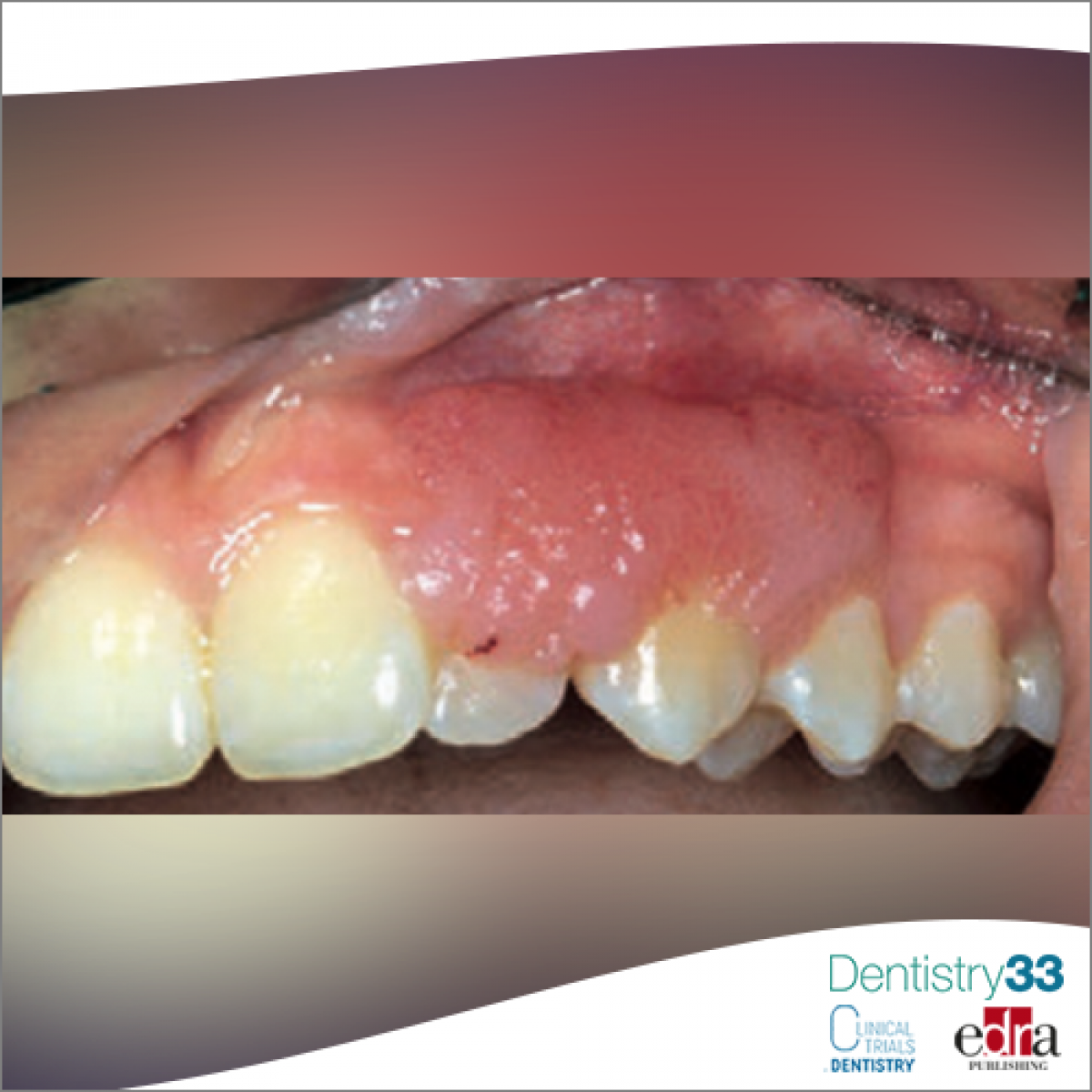
Gingival maxillary enlargement in a young patient
authors: G. Mergoni, I. Giovannacci, G. Giunta, G. Ghidini, M. Meleti, M. Manfredi, P. Vescovi
An 11-year-old patient referred to her pediatrician for a maxillary gingival lesion that had arisen about 2 months earlier and rapidly increased in size was presented for our observation. The child appeared to be in good health and did not complain of any discomfort, except the inability to properly brush the teeth partially covered by the growth.
The lesion extended at the level of the vestibular gingiva from the distal margin of element 2.1 to the medial portion of element 2.4. The external surface had a finely cobbled appearance, mainly pink and with some bright red spots (fig. 1). On palpation, the consistency was similar to that of the surrounding gingiva.
With the aid of a periodontal probe it was possible to suspect that the implant base, which cannot be assessed upon inspection, was considerably smaller than the external surface. Tooth elements 1.1 to 2.5 were viable and showed no mobility. On physical examination, no other lesions were found in the oral mucosa and perioral skin.
The pediatrician, to exclude a peripheral manifestation of an hematological pathology, had already requested blood tests (complete blood count, protein electrophoresis, liver and kidney function) which were found to be normal. The radiographs made by the treating dentist excluded pathological alterations at the level of the alveolar bone and the roots of the dental elements.
Among the differential diagnoses are considered squamous papilloma (frequently found in the oral mucosa, but generally smaller in size), reactive lesions that typically develop on the gum (such as pyogenic granuloma, fibrous epulis, peripheral gigantic cell granuloma and peripheral ossifying fibroma), lymphangioma and spongiotic gingivitis. The latter occurs mainly in female subjects in puberty (10-15 years) on the vestibular aspect of the maxillary gingiva in the form of exophytic lesions, well demarcated, erythematous, with a granular or slightly papillary surface. Although many features are compatible with the case in question, the presence of a narrow implant base reduces the likelihood of this diagnosis. Lymphangioma is
a lesion that originates from the lymphatic vessels and is currently considered more of an amar- toma or a developmental anomaly than a real tumor. It manifests itself in the first two years of life and, when it develops superficially at the level of the oral mucosa, it assumes a defined “fish egg” appearance, similar to that observed in the case described. However, the onset during puberty is very rare.
Since the clinical and anamnestic characteristics are strongly suggestive for a benign pathology, after obtaining informed consent according to current legislation, we proceed with the complete separation of the neoformation and the histological examination. The pathologist observes a proliferation of keratinized stratified squamous epithelium, organized in digitiform protrusions along a fibrovascular axis, compact
bile with the diagnosis of squamous papilloma. It is a pathology induced by the Human Papilloma Virus (HPV). It has been calculated that squamous papilloma represents up to 8% of all neoformations subjected to biopsy in children. It usually manifests as an exophytic, soft, generally pedunculated formation with a warty or “cauliflower” surface with superficial projections that may be pointed or blunt. It tends to grow rapidly until it reaches a maximum size of about 0.5 cm which then remains stable over time. However, as in the case described, lesions greater than 3 cm have been observed in rare circumstances. Squamous papilloma has no degenerative potential, is treated with surgical excision and generally does not recur.
 Related articles
Related articles
Authors: G. Mergoni, I. Giovannacci, G. Giunta, G. Ghidini, M. Meleti, M. Manfredi, P. Vescovi
An 11-year-old patient was sent to out observation by her pediatrician for a maxillary gingival lesion that had arisen about 2 months earlier and...
Oral pathology 25 November 2025
Virtual microscopy (VM) is a technology for showing microscope slides using computers and could be considered a progression of classic methodology using optical microscopes.
Oral pathology 10 November 2025
Evolution of dental informatics as a major research tool in oral pathology
Bioinformatics is a relatively new field of science that incorporates the principles of biology and computer science.
Oral pathology 04 September 2025
The classic dental diseases, caries and periodontal disease, are commonly thought to have little effect on systemic health.
 Read more
Read more
Oral Hygiene & Prevention 05 January 2026
To assess effectiveness of an oral health education (OHE) programme on oral hygiene knowledge, practices, plaque control and gingival health of 13- to 15-year-old school children in Bangalore city.
Editorials 05 January 2026
Products 05 January 2026
Heartland Dental, the nation’s leading dental support organization, today announced that it has selected Dentira as the enterprise lab management platform for supported practices.
News 05 January 2026
Dentistry.One, a virtual-first dental care solution headquartered in Metuchen, NJ, announced it has been named the NJBIZ 2025 For-Profit Business of the Year (1–49 employees).
News 05 January 2026
Health-E Commerce, parent brand to FSA Store and HSA Store, the first and leading online stores dedicated to selling only FSA- and HSA-eligible products and services, recently announced a telehealth...














